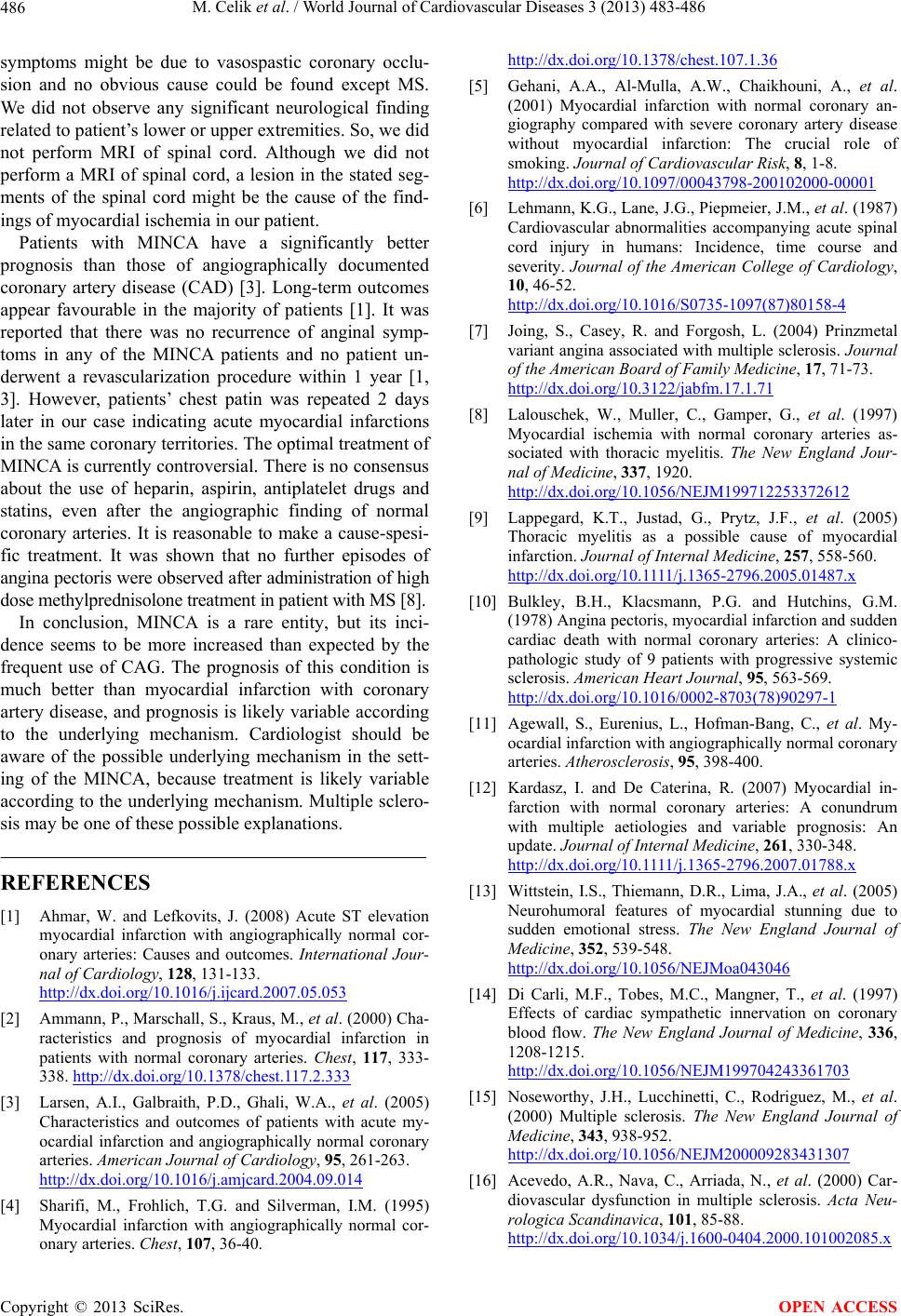
M. Celik et al. / World Journal of Cardiovascular Diseases 3 (2013) 483-486
486
symptoms might be due to vasospastic coronary occlu-
sion and no obvious cause could be found except MS.
We did not observe any significant neurological finding
related to patient’s lower or upper extremities. So, we did
not perform MRI of spinal cord. Although we did not
perform a MRI of spinal cord, a lesion in the stated seg-
ments of the spinal cord might be the cause of the find-
ings of myocardial ischemia in our patient.
Patients with MINCA have a significantly better
prognosis than those of angiographically documented
coronary artery disease (CAD) [3]. Long-term outcomes
appear favourable in the majority of patients [1]. It was
reported that there was no recurrence of anginal symp-
toms in any of the MINCA patients and no patient un-
derwent a revascularization procedure within 1 year [1,
3]. However, patients’ chest patin was repeated 2 days
later in our case indicating acute myocardial infarctions
in the same coronary territories. The optimal treatment of
MINCA is currently controversial. There is no consensus
about the use of heparin, aspirin, antiplatelet drugs and
statins, even after the angiographic finding of normal
coronary arteries. It is reasonable to make a cause-spesi-
fic treatment. It was shown that no further episodes of
angina pectoris were observed after administration of high
dose methylprednisolone treatment in patient with MS [8].
In conclusion, MINCA is a rare entity, but its inci-
dence seems to be more increased than expected by the
frequent use of CAG. The prognosis of this condition is
much better than myocardial infarction with coronary
artery disease, and prognosis is likely variable according
to the underlying mechanism. Cardiologist should be
aware of the possible underlying mechanism in the sett-
ing of the MINCA, because treatment is likely variable
according to the underlying mechanism. Multiple sclero-
sis may be one of these possible explanations.
REFERENCES
[1] Ahmar, W. and Lefkovits, J. (2008) Acute ST elevation
myocardial infarction with angiographically normal cor-
onary arteries: Causes and outcomes. International Jour-
nal of Cardiology, 128, 131-133.
http://dx.doi.org/10.1016/j.ijcard.2007.05.053
[2] Ammann, P., Marschall, S., Kraus, M., et al. (2000) Cha-
racteristics and prognosis of myocardial infarction in
patients with normal coronary arteries. Chest, 117, 333-
338. http://dx.doi.org/10.1378/chest.117.2.333
[3] Larsen, A.I., Galbraith, P.D., Ghali, W.A., et al. (2005)
Characteristics and outcomes of patients with acute my-
ocardial infarction and angiographically normal coronary
arteries. American Journal of Cardiology, 95, 261-263.
http://dx.doi.org/10.1016/j.amjcard.2004.09.014
[4] Sharifi, M., Frohlich, T.G. and Silverman, I.M. (1995)
Myocardial infarction with angiographically normal cor-
onary arteries. Chest, 107, 36-40.
http://dx.doi.org/10.1378/chest.107.1.36
[5] Gehani, A.A., Al-Mulla, A.W., Chaikhouni, A., et al.
(2001) Myocardial infarction with normal coronary an-
giography compared with severe coronary artery disease
without myocardial infarction: The crucial role of
smoking. Journal of Cardiovascular Risk, 8, 1-8.
http://dx.doi.org/10.1097/00043798-200102000-00001
[6] Lehmann, K.G., Lane, J.G., Piepmeier, J.M., et al. (1987)
Cardiovascular abnormalities accompanying acute spinal
cord injury in humans: Incidence, time course and
severity. Journal of the American College of Cardiology,
10, 46-52.
http://dx.doi.org/10.1016/S0735-1097(87)80158-4
[7] Joing, S., Casey, R. and Forgosh, L. (2004) Prinzmetal
variant angina associated with multiple sclerosis. Journal
of the American Board of Family Medicine, 17, 71-73.
http://dx.doi.org/10.3122/jabfm.17.1.71
[8] Lalouschek, W., Muller, C., Gamper, G., et al. (1997)
Myocardial ischemia with normal coronary arteries as-
sociated with thoracic myelitis. The New England Jour-
nal of Medicine, 337, 1920.
http://dx.doi.org/10.1056/NEJM199712253372612
[9] Lappegard, K.T., Justad, G., Prytz, J.F., et al. (2005)
Thoracic myelitis as a possible cause of myocardial
infarction. Journal of Internal Medicine, 257, 558-560.
http://dx.doi.org/10.1111/j.1365-2796.2005.01487.x
[10] Bulkley, B.H., Klacsmann, P.G. and Hutchins, G.M.
(1978) Angina pectoris, myocardial infarction and sudden
cardiac death with normal coronary arteries: A clinico-
pathologic study of 9 patients with progressive systemic
sclerosis. American Heart Journal, 95, 563-569.
http://dx.doi.org/10.1016/0002-8703(78)90297-1
[11] Agewall, S., Eurenius, L., Hofman-Bang, C., et al. My-
ocardial infarction with angiographically normal coronary
arteries. Atherosclerosis, 95, 398-400.
[12] Kardasz, I. and De Caterina, R. (2007) Myocardial in-
farction with normal coronary arteries: A conundrum
with multiple aetiologies and variable prognosis: An
update. Journal of Internal Medicine, 261, 330-348.
http://dx.doi.org/10.1111/j.1365-2796.2007.01788.x
[13] Wittstein, I.S., Thiemann, D.R., Lima, J.A., et al. (2005)
Neurohumoral features of myocardial stunning due to
sudden emotional stress. The New England Journal of
Medicine, 352, 539-548.
http://dx.doi.org/10.1056/NEJMoa043046
[14] Di Carli, M.F., Tobes, M.C., Mangner, T., et al. (1997)
Effects of cardiac sympathetic innervation on coronary
blood flow. The New England Journal of Medicine, 336,
1208-1215.
http://dx.doi.org/10.1056/NEJM199704243361703
[15] Noseworthy, J.H., Lucchinetti, C., Rodriguez, M., et al.
(2000) Multiple sclerosis. The New England Journal of
Medicine, 343, 938-952.
http://dx.doi.org/10.1056/NEJM200009283431307
[16] Acevedo, A.R., Nava, C., Arriada, N., et al. (2000) Car-
diovascular dysfunction in multiple sclerosis. Acta Neu-
rologica Scandinavica, 101, 85-88.
http://dx.doi.org/10.1034/j.1600-0404.2000.101002085.x
Copyright © 2013 SciRes. OPEN ACCESS